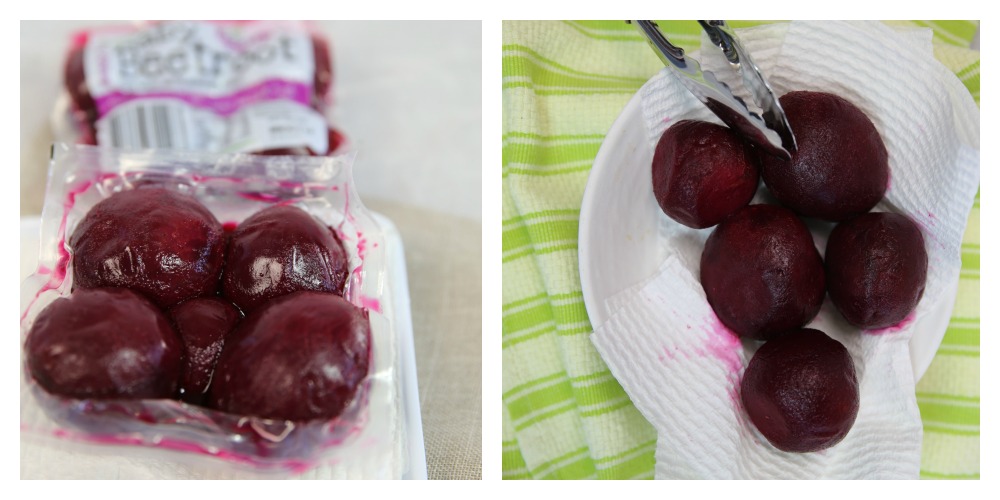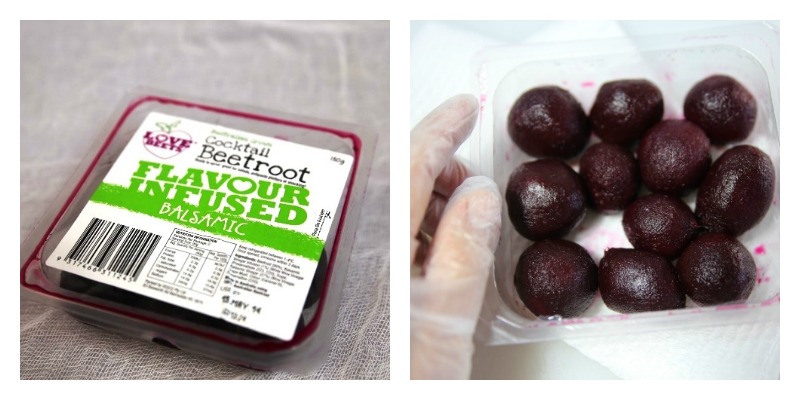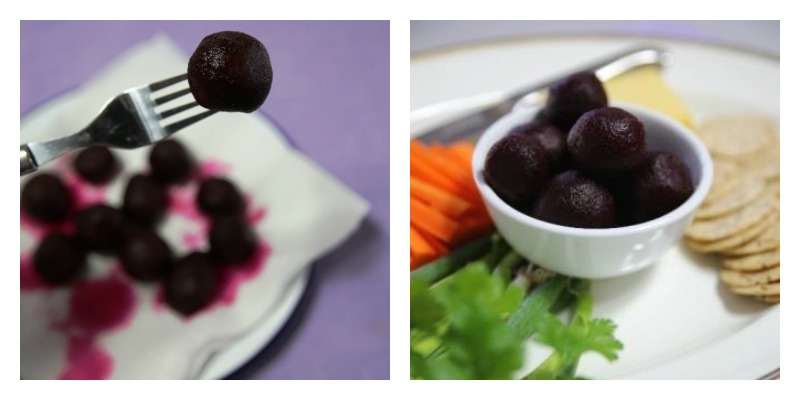Product Review: Love Beets

I’m a fan of beetroot and love it in salads – imagine whole cooked beets tossed through mint leaves, coriander, orange segments, radish and pearl couscous. Yum. And there’s nothing more Aussie than a slice of that purple root peeping out of a burger or steak sandwich. So when I received a sample of the new Love Beets vacuum-sealed, whole cooked, baby beetroots, I had to “give them a go”.
I took the pack away with me on holidays when we went to the bush to where my brother-in-law has a large sheep and cattle property and there are no shops selling things fresh, let alone a vegie market! Yes there are lots of cans of the usual sliced sweetish beetroots at the town store but it’s too sweet and too soft for salads and anything other than filling a toasted sandwich or burger.
I used my 250g pack of five average-sized beets to make up a lovely salad with Puy (French-style) brown lentils, mixed leaves (hard to keep in the country), purple onion, cranberries and globs of feta. We served it alongside a leg of roast lamb and found it a delicious match.
Taste 8 out of 10
Love Beets taste just like beetroot you’ve peeled and cooked yourself but without the hassle! I found them easy to use and was pleased that there was no added salt or sugar. It was just beetroot and a dribble of juice, that’s all. They had their characteristic natural sweetness with a subtle earthy flavour which I find so appealing.

Though they had a firmer texture than soft, canned, baby beets and were cooked right through, they weren’t as firm to bite as my own home-cooked beets. Still, no problem using them for salads and sides. I still had to don gloves to handle them as yes, you’ll find your fingers stained a pretty pink! Available in 250 g and 500 g pouches, they are cooked then vacuum packed, ready to cut open, drain and use, according to the manufacturer.
There are also three flavoured variants: sweet and sour (vinegar flavour), Balsamic infused and Chilli infused. I liked the plain ones for salads and sides which I felt were more versatile and allowed me to add the flavours I wanted. But the infused cocktail beets were easy to serve with drinks (see picture below).
Nutrition 19 out of 20
Love Beets are 100% beetroot, no sugar, salt or additives. Cooked or raw, beetroot or table beet (Beta vulgaris) is a wonderfully healthy root vegetable in its own right and gives us:
- Folate which is great for women planning a pregnancy.
- Fibre, which helps keep your digestive tract working well (note: be warned that your faeces may carry a reddish colour after consuming beetroot. Don’t be alarmed. It’s not blood!)
- Nitrates, which have been shown to check dementia and lower blood pressure.
- Little salt which is a big advantage over canned beetroot which has six times the sodium levels (300 mg vs 50 mg per 100 g).
- The minerals manganese, potassium and magnesium, which help regulate fluid balance and muscle contractions.
Beetroot’s blue-red colour comes from anthocyanins, compounds that are related to the antioxidants in red wine and blueberries. These natural chemicals help keep you looking youthful and can fight off some cancers and can even kill off harmful bacterial. Eat up!
Like most vegetables, beetroot has virtually no fat, is high in fibre and low in kilojoules/calories. At 64, it has a medium-high GI (Glycemic Index) and a low GL (Glycemic Load) of 2, which means it is converted into blood glucose relatively slowly and therefore helps to keep blood glucose levels stable.

Convenience 8 out of 10
If you find beetroot too hard to cook or just too messy, Love Beets are for you. No more pink fingers from peeling beetroot or beetroot stains all over the kitchen (which is why I wear gloves to do this messy job over the sink - see picture).
Peeled and cooked in their own juices, with no added sugar or salt, they are ready to be eaten as they are or to use in a salad, roasted in the oven or as part of a dip or juice. I’ve even seen a recipe for chocolate cake made with grated beetroot. Easy.
Not forgetting how easy it would be to whip up a classic Polish or Russian borscht, or a quick grated beetroot salad with carrot and apple.
Storage
The plain beetroot is just that, 100% plain beetroot and can be stored in your pantry until the use-by-date - around 6 months - before opening. Once opened it should be refrigerated and used within 3 days. The plain one is the only one with no additives. The cocktail (flavour infused varieties) need to be refrigerated even before you open them and they also contain preservatives so check the label if you have food allergies or sensitivities.
Love beetroot in cookery
- Beetroot juice has gained popularity since Paralympic athlete and gold medallist, David Weir, announced that a shot of the juice was his secret to success.
- Chef and cookery writer, Yotam Ottolenghi, recommends mixing it with yoghurt and preserved lemon relish.
- Hugh Fearnley-Whittingstall of Little River Cottage fame pairs it with mozzarella and balsamic.
- Nigel Slater, a self-styled “cook who writes”, suggests serving beetroot with lamb (as I did), or making it into fritters and pairing it with gravlax.

Sustainability 9 out of 10
I enjoyed the sample I received so much that I've bought this product several times myself and I felt good supporting Aussie farmers. Love Beets are produced by OneHarvest in its production facility in Bairnsdale in country Victoria, using beetroot grown in Cowra in New South Wales according to their website. OneHarvest is an Australian family-owned business that’s been growing and packing fresh produce for 30 years. Full marks to them for taking a risk with this new form of packing which was small and wouldn’t take up much room in landfill though it would be better still if it were biodegradable.
Where to buy
Love Beets are available in the chilled salad section at major supermarkets, independent supermarkets and greengrocers. They retail for around $3.50 for a 250 g pack of the plains or $4 for the cocktail (flavour infused) types.
Overall Score 4 Apples
Final score = 44/50 which means 4 Apples:

The bottom line
A top product. I love beetroot in this new, convenient format. I'll look out for it again when shopping.



